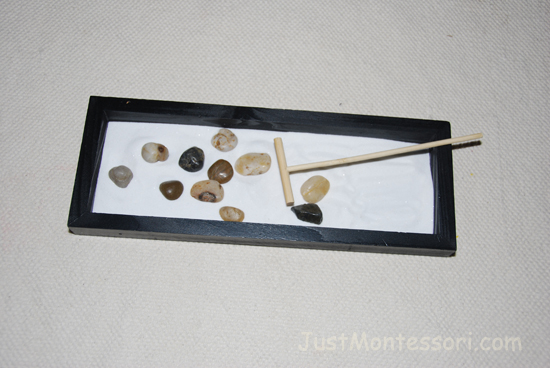Book choices for today:
The Boy in the Garden Allen Say
One Leaf Rides the Wind Celeste Davidson Mannis
Mr. Hiroshis Garden Maxine Trottier
What is a Screw Llyod Douglas
Screws in Action Gillian Gosman
Screws Sarah Tieck
Screws to the Rescue Thales and Sharon
Get to Know Screws Paul Challen
Geography: (first circle)
Need for lesson – Pictures of Japanese gardens and a miniature garden for children to use.
Geography 38
Today we want to talk a little about Japanese gardens. Garden design is an important Japanese art form that has been around for many years. These types of gardens are designed to create a miniature reproduction of natural scenery. They are designed so beautifully and intended as peaceful quiet places one can go to. In a Japanese garden you wouldn’t find a square pond because perfectly square ponds do not naturally exist in nature. There are different styles of Japanese gardens. Some may only have stone, gravel, and sand. This kind of garden is called a karesansui. The sand can be raked to make patterns. Stones can be piled to look like mountains. Other elements that can be found in the gardens are things such as ponds, waterfalls, bridges, hills, islands, trees, shrubs, bamboo, lanterns, and a water basin which is often found in tea garden. Remember we talked about the tea ceremony, well, you would walk through a tea garden before you entered a tea house. Other kinds of gardens are the courtyard garden and a strolling garden.
Let’s look at some pictures of the different styles of Japanese gardens.

(from: Japanses Gardens by Geeta K. Mehta, Japanese Stone Gardens by Stephen Mansfield, and Creating Japanese Gardens by Philip Cave)


I combined the garden with the water board as a Japaneses Table work choice.
Art:
Japanese Garden – Children can make little gardens in a shoe box lid. Provide sand, pebbles, egg cartons (can be cut to make lanterns), paint and markers (to draw ponds), paper (can be folded and glued for bridges), and tissue paper (to make flowers and shrubs). If children decide to make a sand garden little rakes can be purchased at a hobby store.

Science: (second circle)
Need for lesson – A variety of screw samples.
Science 60
Today we will talk about our last simple machine. It is the screw. Screws are devices that can lift or hold things together. Screws can do two things. First, they can convert a force that goes around and around into a force that goes up and down. Second, screws can thread into things like wood or a metal bolt so that the two things are interlocked and can’t come apart. Screws are good for holding things together because of the threads around the shaft. The threads grip the surrounding material like teeth, resulting in a secure hold. The only way to remove a screw is to unwind it. A screws power depends on how close together the threads are. The threads are the parts that stick out, they feel bumpy. You get more power if the threads are closer together. A car jack is a sample of a screw-type simple machine that enables one person to lift up one side of a car to change a tire.
It may seem like a little thing, screws, but they are considered simple machines because of the job they do. They help a person to do a job, easier!

-
 (G) Weeks 23-26$25.00
(G) Weeks 23-26$25.00


